
by Deep Green Resistance News Service | Sep 14, 2017 | Colonialism & Conquest, Mining & Drilling
Featured image: A still from aerial footage from 2011 of an uncontacted Amazon tribe in Brazil near the Peruvian border. © BBC/FUNAI/Survival
by Survival International
Brazilian Indians have appealed for global assistance to prevent further killings after the reported massacre of uncontacted tribespeople, and have denounced the government cuts that left their territories unprotected.
Paulo Marubo, a Marubo indigenous leader from western Brazil, said: “More attacks and killings are likely to happen. The cuts to FUNAI’s funding are harming the lives of indigenous people, especially uncontacted tribes, who are the most vulnerable.” (FUNAI is Brazil’s indigenous affairs agency).
Mr. Marubo is the leader of Univaja, an indigenous organization defending tribal rights in the Uncontacted Frontier, the area with the highest concentration of uncontacted tribes in the world.
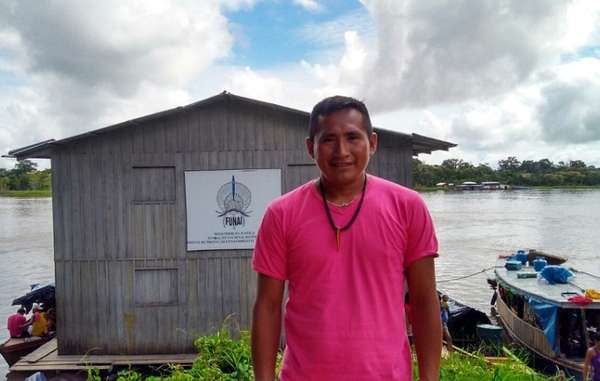
Paulo Marubo, leader of a Javari Valley indigenous organization from the Uncontacted Frontier. © Amazonas Atual
COIAB, the organization representing Indians across the Brazilian Amazon, denounced the massive cutbacks to FUNAI’s budget that has left many tribal territories unprotected:
“We vehemently condemn these brutal and violent attacks against these uncontacted Indians. This massacre shows just how much the rights of indigenous peoples in this country have been set back [in recent years].
“The cuts and dismantling of FUNAI are being carried out to further the interests of powerful politicians who want to continue ransacking our resources, and open up our territories for mining.”
Unconfirmed reports first emerged from the Amazon last week that up to 10 uncontacted tribal people had been killed by gold miners, and their bodies mutilated and dumped in a river.
The miners are reported to have bragged about the atrocity, whose victims included women and children, in a bar in a nearby town. The local prosecutor’s office has opened an investigation.
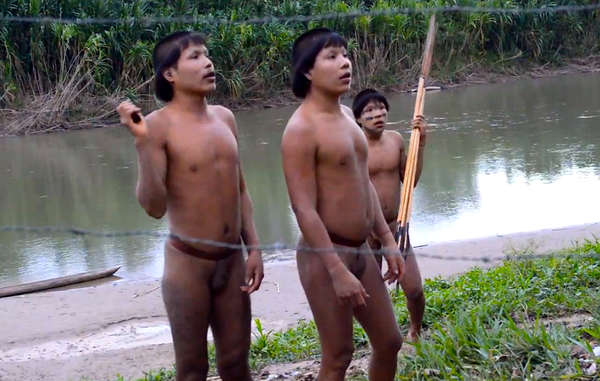
These Sapanawa Indians made contact in 2014. They reported their community had been attacked, and so many members of the village killed that they could not bury the dead. © FUNAI/Survival
The alleged massacre was just the latest in a long line of previous killings of isolated Indians in the Amazon, including the infamous Haximu massacre in 1993, in which 16 Yanomami Indians were killed by a group of gold miners.
More recently, a group of Sapanawa Indians emerged in the Uncontacted Frontier, reporting that their houses had been attacked and burnt to the ground by outsiders, who had killed so many members of the community that they had not been able to bury all the bodies.
All uncontacted tribal peoples face catastrophe unless their land is protected. Survival International is campaigning to secure their land for them, and to give them the chance to determine their own futures.
Survival’s Director Stephen Corry said: “The decision by the Brazilian government to slash funding for the teams that protect uncontacted Indians’ territories was not an innocent mistake. It was done to appease the powerful interests who want to open up indigenous lands to exploit – for mining, logging and ranching. These are the people the Indians are up against, and the deaths of uncontacted tribes won’t put them off. Only a global outcry can even the odds in the Indians’ favor, and prevent more such atrocities. We know public pressure works – many Survival campaigns have succeeded in the face of similar odds.”

by Deep Green Resistance News Service | Sep 8, 2017 | Human Supremacy
Featured image: Bonanza Flats
Editor’s note: This is the second installment in a multi-part series. Browse the New Park City Witness index to read more.
by Will Falk / Deep Green Resistance
Before murdering millions during the Holocaust, the Nazis referred to Jews as rats. After murdering 17 people and lobotomizing some of his victims in an attempt to preserve them, alive but in a catatonic state, serial killer Jeffrey Dahmer explained, “…I tried to create living zombies…I just wanted to have the person under my complete control, not having to consider their wishes, being able to keep them there as long as I wanted.” In vivisection labs, scientists commonly cut animals’ vocal cords, so the scientists don’t have to listen to the animals scream.
These examples illustrate a common psychological phenomenon: In order to commit atrocities, humans characterize their victims as sub-human, objectify and silence them. It is, after all, much easier to destroy the less than human and the voiceless.
Civilized humans are currently destroying the natural world. Water continues to be polluted, air is poisoned, soil is lost faster than it can be replaced, and the collapse of every major biosphere across the planet intensifies. This destruction is made possible through the objectification and silencing of the natural world. The American legal system defines nature as property. Capitalism calls nonhumans “natural resources” and only values them as profits. The Abrahamic religions remove the sacred from the natural world and give it to an abstract, patriarchal God who somehow exists beyond the natural world.
It’s no wonder, then, that many in Park City participate in the silencing of nature, too. Many Parkites, for example, celebrate the existence of thousands of acres of land designated as “protected open space.”
There are several problems with this. First, the term “open space” is dishonest and works to objectify nonhumans while silencing the natural world. Objectification and silencing pave the way for exploitation. Second, as long as runaway climate change threatens snowfall, creates droughts, and contributes to wildfire intensity, no natural community in Park City can truly be considered “protected.” To call endangered natural communities protected leads to complacency, and we cannot afford complacency while the world burns.
The “Save Bonanza Flats” Campaign, which raised $38 million to protect 1,350 acres of high-altitude land from development, was a beautiful expression of the community’s love for life. Do not mistake me, I am deeply glad that Bonanza Flats is safe from hotels and multi-million dollar homes. But, Bonanza Flats is not safe, and will never be safe, as long as the dominant culture’s insatiable appetite for destruction is ensured by humans who believe the natural world is nothing more than lifeless matter for humans to use.
***
While working on this essay, I decided to head up Guardsman Pass to ask those who live in Bonanza Flats what they think about “protected open space.” Hiking is contemplative for me. I was asking myself just how, exactly, I thought the nonhumans in Bonanza Flats would express their feelings about being “open space” when I rounded a bend to find myself face to face with a bull and cow moose grazing among the aspen.
The aspen were mature, many of them boasting trunks eighteen and twenty-four inches in diameter. They grew closely together, creating an ancient silvan atmosphere with dappling silvers, golds, and greens. The afternoon sunshine mixed with aspen leaves to give me the slight, pleasant sense of existential vertigo that accompanies the timelessness of life’s original joys.
I met the bull moose’s gaze. My bones recognized their nearness to a greater collection of their kindred. My muscles, observing the moose’s, remembered their first purpose and tingled with excitement. His eyes, browns in brown, reflected all the different woods he’d ever strode through. I’m not sure how long we considered each other, but when he finally looked away, his wisdom was undeniable.
And, I had my first answer: To share an aspen grove with a bull moose in Bonanza Flats, is to know this space is anything but open.

I continued on to find a stone to sit on and watched the lazy orange flutter of butterfly wings. I listened to the soft hum of bees, the breeze through quaking aspen leaves, and the hypnotic click of grasshoppers in flight. I saw mule deer bounding over a fence, a red-tailed hawk riding wind pockets, and squirrels tossing pine cones to the ground, narrowly missing human heads (for the squirrels’ winter caches). All these beings confirmed the lesson the bull moose taught me. Bonanza Flats is not open, it is filled with countless living beings.
An approaching rain cloud brought tidings of the radical interconnectedness of all life and proved that Bonanza Flats is not truly protected. When the cloud arrived to give its water, the rain evaporated well before it reached us. I was reminded that Bonanza Flats, like all communities along the Wasatch Range, depend on snowpack for life-giving water. Simple arithmetic tells us that as long as total snowpack diminishes decade after decade, as it has been since the 1950s, sooner or later there won’t be enough water left.
While Bonanza Flats is safe from the developers’ bulldozers and chainsaws, many threats, just as deadly, still exist. Marssonina fungus spores, aided by climate change, could spread over aspen leaves until they no longer quake. Shorter winters allow the tiny pricks of too many tick bites to suck moose lives away. The worrisome scent of wildfire smoke haunts the wind. And, the asthmatic cough of children brought to the mountains by their parents to escape the Salt Lake Valley’s terrible air quality ring across Bonanza Flats’ trails.
***
Not all humans have objectified and silenced the natural world. For the vast majority of human history, humans lived in balance with the natural world we depend on. We lived in this way, in part, because we developed cultures that taught the sacredness of the natural world.
I’m writing this from the eastern edge of the Great Basin where the Western Shoshone, Paiute, Goshute, Washo and others lived sustainably for millennia. Much of my work in the region has been to protect pinyon-juniper forests from government-sponsored clearcuts. The forests make poor livestock grazing and ranchers make more money when the forests are replaced with grasses, so the forests are demonized. And, just like the demonization of Jews led to the Holocaust, the demonization of pinyon-juniper forests leads to millions of acres of clear-cuts.
Food from pinyon pine nuts and medicine from juniper trees were staples in many of the Great Basin’s traditional cultures. Pine nuts and juniper berries can be harvested without damaging the forests, so native peoples lived on what the land freely gave. In my research, I stumbled upon the transcript of a presentation[1] Glenn E. Wasson, a Western Shoshone man, gave at a pinyon-juniper conference hosted by the University of Nevada-Reno, the United States Forest Service, and the Bureau of Land Management. His words describe his people’s spirituality and represent a healthy relationship with the natural world.
Wasson said, “Each living entity constitutes a link in the chain of life. All those seen and unseen, all who grow from the ground, all those who crawl, all those who swim, all those who walk on legs, all those who fly, are all intertwined in the chain of life. Each plays a vital role in the keeping of a strong, healthy, and living Mother Earth, who provides each and every entity with all the necessities for life.” Contrast Wasson’s worldview with the dominant culture’s conception of nature as property, as resources, as objects and we begin to see why we’re in the mess we’re in.
While criticizing the Forest Service and BLM’s treatment of pinyon-juniper forests, Wasson described the mindset all of us must embrace. He said “…the cutting down of a single living tree is sacrilegious – the cutting down of a forest – UNTHINKABLE!” Until we begin to see individual nonhumans as sacred and natural communities worthy of our utmost respect, the destruction will continue.
Simply changing our language will not stop the destruction and I am not criticizing anyone’s efforts to protect Bonanza Flats from development. We need much more than better words and any land that stands free of development today, has a chance to stand free of development tomorrow. Land developed today may take decades to recover.
It’s not just Bonanza Flats. Park City boasts 8,000 acres of so-called protected open space. These are not protected open spaces. These are living natural communities where countless nonhumans live with lives as valuable to them as yours is to you. And, their lives are under attack.
I’m not writing anything you don’t already know. Most people in Park City are concerned about the natural world. Unfortunately, it appears that most Parkites are more interested in using the natural world, than in saving it. Why do I say this? Well, ask yourself, do most people in Park City spend more time confronting the forces destroying snow, or more time skiing on it? Do most people spend more time working to protect threatened Canada lynx, or more time mountain biking through Canada lynx’ homes? Do most people spend more time trying to save Colorado Pikeminnows, or more time flying fishing the waters Colorado Pikeminnows swim through?
There’s nothing wrong with enjoying the natural world. But, nonhumans do not exist for human enjoyment, they exist for themselves. It is only through centuries of cultural conditioning, teaching us to see the natural world as full of objects for our use, that some humans find nothing wrong with spending more time riding bikes than fighting for our nonhuman kin.
Life is created by complex collections of relationships formed by living creatures in natural communities. Water, air, soil, climate, and the food we eat depend on natural communities. The needs of these communities are primary; morality, the efforts of our daily lives, and our cultural teachings must emerge from a humble relationship with these natural communities. True sustainability is impossible without this.
Not long ago, all humans lived in humble relationships with natural communities. We developed traditional cultures that were rooted in the connectedness of all living beings. These cultures insisted upon the inherent worth of the natural communities who gave us life. Members of these cultures did not know “open spaces,” they knew places filled with those who grow from the ground, those who crawl, those who swim, those who walk on legs, and those who fly.
The dominance of a culture that objectifies and silences nature and calls natural communities “open space” enables its destruction. This culture has pushed the planet to the verge of total collapse. To avert collapse, the destruction must stop. We must create cultures where the exploitation of individual nonhumans is sacrilegious, and wholesale environmental destruction is unthinkable. We must stand in solidarity with all those – human and nonhuman – who share this living community we call Park City.
[1]Wassen, G.E. 1987. The American Indian response to the pinyon-juniper conference. In: Everett, R.L., comp. Proceedings: Pinyon-juniper conference. Gen. Tech. Rep. INT-GTR-215. Ogden, UT: U.S. Department of Agriculture, Forest Service, Intermountain Research Station: 38-41.
To repost this or other DGR original writings, please contact newsservice@deepgreenresistance.org
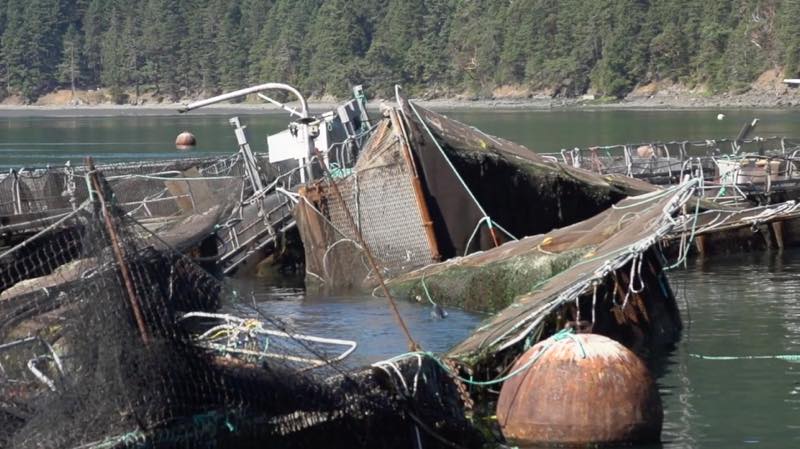
by Deep Green Resistance News Service | Aug 29, 2017 | Agriculture
Featured image: Still from video showing the broken pens of 300,000 Atlantic salmon that escaped from a fish farm off Cypress Island in Washington State. Vimeo/Wild Fish Conservancy
The Lummi Nation, the third largest tribe in Washington State, is in a state of emergency following the structural collapse of the Cooke Aquaculture open net-pen facility near Puget Sound. The breach released more than 300,000 farmed Atlantic salmon into Pacific waters, adjacent to Cypress Island, just east of the Canadian border near Victoria B.C.
State officials announced over the weekend that no new permits would be issued for fish farm operations until the cause of the incident was determined. Lummi Nation Fisheries have been catching thousands of Atlantic salmon alongside wild Pacific salmon for several days, but officials still believe many of the invasive fish are already on their way to spawn in local streams and rivers. Tribal fishermen have hauled in at least 200,000 pounds of invasive Atlantic salmon since the emergency declaration, the Lummi said on Monday August 28.
“This disaster could have devastating effects and could potentially decimate this year’s run of Chinook salmon,” said Lummi Natural Resources Director Merle Jefferson. “This is unacceptable for all residents of the Puget Sound. We are doing what we can to help limit the damage, but as far as we know, containment is indefinite. These invasive fish are going to find our rivers.”
Kurt Beardslee, director of the Wild Fish Conservancy Northwest (WFCN) called the incident an environmental disaster and is preparing to file a civil suit against Cooke Aquaculture under section 505 of the Clean Water Act.
“This dangerous and reckless industry not only threatens the recovery of our native salmon and orca populations but also threatens the health of Puget Sound and the Northwest’s cultural identity,” Beardslee said in a WFCN press release.
Following the failure of the net-pen that contained 305,000 Atlantic salmon, Cooke Aquaculture cited the “exceptionally high tides” caused by the August 21 solar eclipse as the reason for the breech at its facility. In a statement, Cooke Aquaculture said its Cypress Farm #2, which contained the Atlantic salmon, had been in operation for almost 30 years without incident. In addition the company cited its “solid track record” in modern marine farming at several locations across the globe, including facilities in Maine, Scotland, Spain and Chile.
“It is estimated that several thousand Atlantic salmon escaped following a structural failure of part of the net-pen structure on the Cypress Site 2 farm,” Cooke Aquaculture said in the statement. “It appears that many fish are still contained within the nets. It will not be possible to confirm exact numbers of fish losses until harvesting is completed and an inventory of fish in the pens has been conducted.”
However, tides were almost a foot higher last January than on the evening of the solar eclipse, NPR reported. This left Beardslee “bewildered by the company’s claim that the solar eclipse presented a tidal occurrence that they could not have prepared for,” he said.
Emergency maintenance was performed on the Cypress Island net-pens on July 27, which further calls into question the company’s claim that high tides during the solar eclipse were the cause of the facility’s structural failure. Washington State officials released a guide to help fishermen identify the Atlantic salmon and how to contain them if caught. In addition, Governor Jay Inslee put a hold on new net-pen permits “until a thorough investigation of this incident is completed,” he said in a statement.
“Tribes and others who fish Washington waters deserve a comprehensive response to this incident, including answers to what happened and assurances that it won’t happen again,” Inslee said. “I believe the company must do everything it can to stop any additional escapes and to recover as many fish as possible, including adequate compensation for those working to remove Atlantic salmon from our waters.”
The Quinault Indian Nation said this was a good start, but did not do enough to recognize the threat posed by farmed Atlantic salmon, which is being done with profit rather than health in mind.
“We have been objecting to the open-water farming of Atlantic salmon for years,” said Quinault Nation President Fawn Sharp in a statement. “The disaster near Cypress Island seems to have finally generated a strong response from the state. We’re glad about that. But we want the state and the public to know it’s a serious problem here, too.”
North of the U.S.–Canada border, environmental groups in British Columbia are sounding the alarm once again over the farming of non-native Atlantic salmon in Pacific waters, which could potentially devastate an area that still sees some of the largest wild Pacific salmon runs in the world. Watershed Watch Salmon Society, an environmental organization based out of Coquitlam B.C., called the incident “an epic disaster.” They’re asking anglers to be on the lookout for Atlantic salmon in streams and rivers on the southern edge of Vancouver Island and have renewed calls to end the use of fish farms on the Pacific Coast.
Canada’s federal Department of Fisheries and Ocean (DFO) said the Liberal government is taking the case very seriously and is closely monitoring the situation.
“We will be working to understand the potential impacts of this incident and prevent any damage to Canada’s marine ecosystems, said Minister of Fisheries, Oceans and the Canadian Coast Guard, Dominic LeBlanc in a statement. “DFO is communicating with its U.S. counterparts, the National Oceanic and Atmospheric Administration and other U.S. regulators to help ensure impacts from the incident are minimized.”
The recently formed British Columbia New Democratic Party (NDP) government said in an e-mail it was aware of the situation and would be working closely with DFO. So far no Atlantic salmon have been recovered in Canadian waters. However, government officials are asking B.C. residents to report any and all Atlantic salmon caught in Canadian waters through its Atlantic Salmon Watch Program.
British Columbians have been debating the risk of fish farms for decades. Due to conservation efforts and lobbying in the early 2000s, no fish farms are currently operating along B.C.’s North Coast. However, the Cooke Aquaculture breech is renewing calls to shut down all fish farms along the province’s south coast, which have long been opposed by local First Nations.
Over the years First Nations along the south coast of Vancouver Island have repeatedly called for an end to open net-pen fish farms, claiming they breed diseased, unnatural salmon that can transmit viruses to wild populations and hinder First Nations’ ability to operate food fisheries. Union of B.C. Indian Chiefs Vice President Bob Chamberlin said First Nations have a legal right to practice their traditional ways to gather sustenance from the land, including wild salmon.
“If the government of B.C. and Canada continue to ignore the impacts of open net-pen aquaculture on wild salmon, then we are looking to an imminent future without the constitutionally protected wild salmon food source critical to First Nations in B.C., and without a once proud economic driver that our wild salmon fisheries provide to indigenous and non-Indigenous communities alike,” he said.
Following the release to the Aboriginal Peoples Television Network (APTN) of video showing deformed and diseased Atlantic salmon in open net-pens operated by Grieg Seafood, Hereditary Chief Ernest Alfred of the Nagmis, Lawit’sis and Mamalilikala Nations began occupying a facility near Swanson Island near Vancouver Island, planning to stay until the operation is shut down indefinitely.
“This place is ours, and we’re not moving,” Alfred wrote in a Facebook post. “We must stop open-net fish farms in our waters. It’s time to stand up and take a stand.”
The issue undermines attempts at reconciliation between Indigenous Peoples and the Canadian government, Alfred continued.
“You can’t ignore the issue of rights and title, which are clearly being violated here,” said Alfred. “You have politicians traveling the country talking about reconciliation. How can we have reconciliation when we have this disease running through our territory?”
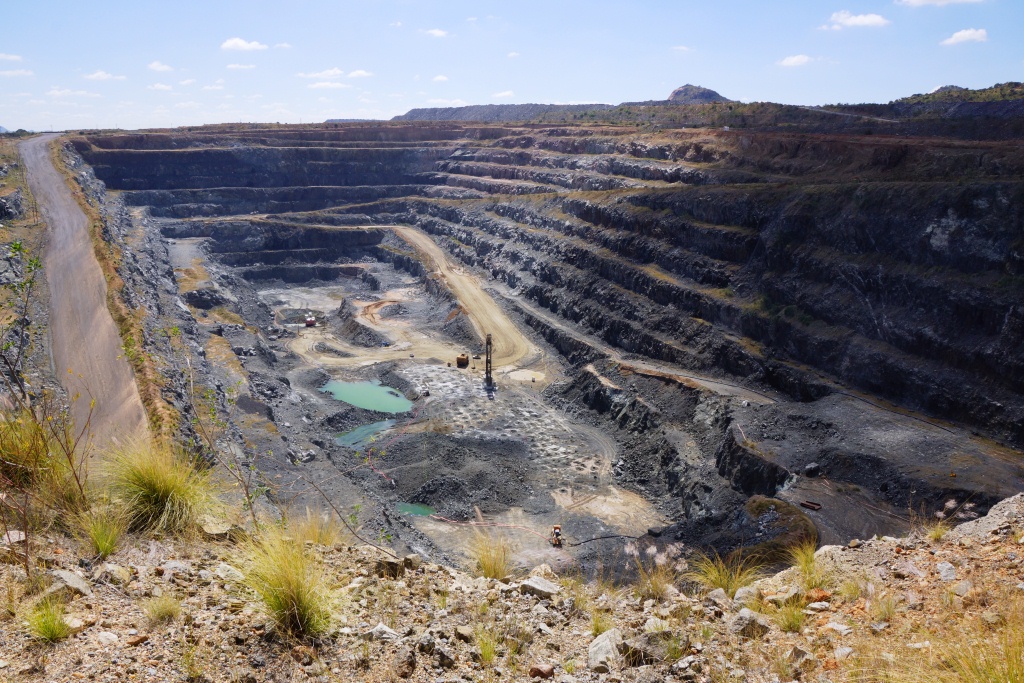
by Deep Green Resistance News Service | Aug 28, 2017 | Toxification
Peak oil extraction has passed and extraction will decline from this point onward. No industrial renewables are adequate substitutes. Richard C. Duncan sums it up in his “Olduvai Theory” of industrial civilization. Duncan predicted a gradual per capita energy decline between 1979 and 1999 (the “slope”) followed by a “slide” of energy production that “begins in 2000 with the escalating warfare in the Middle East” and that “marks the all-time peak of world oil production.” After that is the “cliff,” which “begins in 2012 when an epidemic of permanent blackouts spreads worldwide, i.e., first there are waves of brownouts and temporary blackouts, then finally the electric power networks themselves expire.”34 According to Duncan, 2030 marks the end of industrial civilization and a return to “global equilibrium”—namely, the Stone Age.
Natural gas is also near peak production. Other fossil fuels, such as tar sands and coal, are harder to access and offer a poor energy return. The ecological effects of extracting and processing those fuels (let alone the effects of burning them) would be disastrous even compared to petroleum’s abysmal record.
Will peak oil avert global warming? Probably not. It’s true that cheap oil has no adequate industrial substitute. However, the large use of coal predates petroleum. Even postcollapse, it’s possible that large amounts of coal, tar sands, and other dirty fossil fuels could be used.
Although peak oil is a crisis, its effects are mostly beneficial: reduced burning of fossil fuels, reduced production of garbage, and decreased consumption of disposable goods, reduced capacity for superpowers to project their power globally, a shift toward organic food growing methods, a necessity for stronger communities, and so on. The worst effects of peak oil will be secondary—caused not by peak oil, but by the response of those in power.
Suffering a shortage of fossil fuels? Start turning food into fuel or cutting down forests to digest them into synthetic petroleum. Economic collapse causing people to default on their mortgages? Fuel too expensive to run some machines? The capitalists will find a way to kill two birds with one stone and institute a system of debtors prisons that will double as forced labor camps. A large number of prisons in the US and around the world already make extensive use of barely paid prison laborers, after all. Mass slavery, gulags, and the like are common in preindustrial civilizations. You get the idea.
Featured image: Mogolokwena Platinum Mine, South Africa
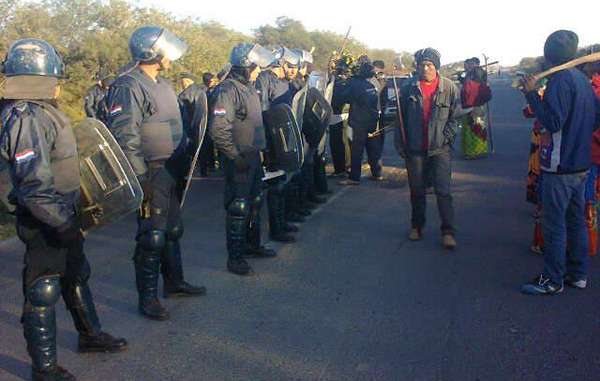
by Deep Green Resistance News Service | Aug 24, 2017 | Biodiversity & Habitat Destruction
Featured image: There have been confrontations between the Ayoreo and the Paraguayan authorities in recent years, as the tribe have protested against the theft and destruction of their land.© GAT/ Survival
by Survival International
Landmark talks between the Paraguayan government and a recently contacted tribe have yet to reach an agreement, allowing rampant deforestation to continue. Some members of the tribe are uncontacted, and live in a rapidly shrinking island of forest.
The talks began six months ago after a petition from the Ayoreo tribe to the Inter-American Commission on Human Rights, an influential body which holds governments in the Americas to account on human rights issues. The Ayoreo have been claiming the right to their ancestral land since 1993.
Halfway through the year-long process, however, and little concrete action has been taken, leading to fears for the tribe’s long-term survival. A technical study is due to be carried out to assess the feasibility of securing the land.
The government has also failed to stop the rapid logging of land owned by the Ayoreo, despite a 2016 emergency order from the Inter-American Commission to protect the uncontacted Indians and halt deforestation.
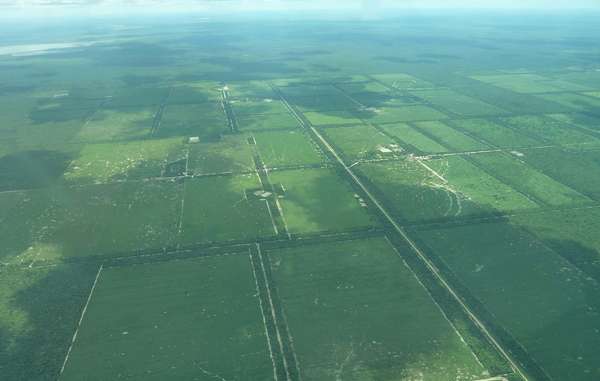
Aerial photograph showing the devastation that logging has brought to Ayoreo land. © Survival
Background briefing
– The Ayoreo live in the Chaco, which is the largest forest in South America outside the Amazon and has recently been recorded as having the highest rate of deforestation in the world. Experts estimate that the forest lost almost 10 million trees in January 2017.
– This poses a deadly threat to the Ayoreo, who face catastrophe unless their land is protected.
– Many members of the Ayoreo tribe were forcibly contacted by missionaries between 1969 and 1986. Continual land invasions forced them to abandon their homes. Many have since suffered from disease, including a TB-like illness, poverty, and exploitation on the fringes of mainstream Paraguayan society.
– Recently contacted members of the tribe spent years fleeing from bulldozers, which they called “beasts with metal skin.” The machines are used by loggers to clear paths for cutting trees.
– The petition which finally brought the Paraguayan government to the negotiating table is called Petition 850-15. It features a claim for the restitution of Ayoreo land.
– In February 2016, the Inter-American Commission issued an emergency order (MC 54-13) calling for the protection of uncontacted Ayoreo and their forests. Although this was in response to a separate petition submitted by the Ayoreo, the orders are to also be discussed during the talks.
– The local support group GAT, and indigenous organization OPIT, have played an important role in lobbying the government, and after months of warning, finally pressed them to investigate the logging in July 2017. It remains to be seen whether the deforestation will be stopped and the perpetrators brought to justice.
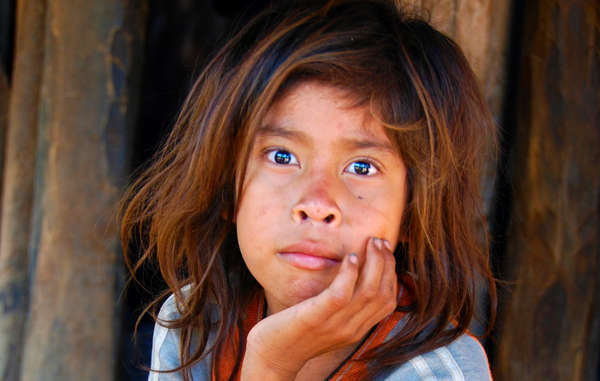
Most of the Ayoreo have been forced out of the forest. They have since been fighting for their land rights. © Survival
Survival International is calling for a complete halt to logging on Ayoreo land, and for the return of all lands which have been titled to ranching companies.
Uncontacted tribes are not backward and primitive relics of a remote past. They are our contemporaries and a vitally important part of humankind’s diversity. Where their rights are respected, they continue to thrive.
They are the best guardians of their environment. And evidence proves that tribal territories are the best barrier to deforestation.
Survival’s Director Stephen Corry said: “The Ayoreo have already been waiting more than twenty years for their lands to be protected. All this time they’ve seen their forests destroyed about them. They hoped the Inter-American Commission’s intervention would finally push the government to act, but that hope too has proved an illusion. Tragically, it seems that Paraguay’s government is so firmly tied to the ranchers and landowners who control the levers of power that nothing short of massive public pressure will move them to act.”
by Deep Green Resistance News Service | Aug 19, 2017 | Toxification
Featured image: Public Health Watch
by Alex Jensen / Local Futures
A recent study of air pollution in the western United States made a startling finding: despite a 50 percent drop over the past 25 years in US emissions of smog-producing chemicals like nitrogen oxides (NOx), smog actually increased during that period in the rural US West – even in such ‘pristine’ environments as Yellowstone National Park. Most of this increase was traced to “the influx of pollution from Asian countries, including China, North and South Korea, Japan, India, and other South Asian countries.”[1] That’s because over the same period that NOx emissions declined in the US, they tripled in Asia as a whole.[2] In media reports of the study, China and India are described as the “worst offenders” of this fugitive “Asian pollution”.[3]
Left only with these findings, a reasonable conclusion would be that the US has become more environmentally enlightened in recent decades, while Asia – particularly ‘developing’ Asia – is a veritable eco-reprobate, sacrificing not only its own but global airsheds to choking pollution. The new, anti-environmental EPA director, Scott Pruitt, recently expressed this view in explaining why the US should exit the Paris Climate Accord: “[China and India] are polluting far more than we are.”[4]
What’s missing?
A similar study of global air pollution drift in 2014, focusing on China and the US, made comparable findings, but included an important factor missing from the more recent study: production for export. Among other things, the scholars of the older study asked how much of the Chinese air pollution drifting to the Western US was occasioned specifically in the production of exports for world markets (including the top destination for Chinese manufactures, the US.)
The answer? In 2006, up to 24% of sulfate concentrations over the western United States were generated in the Chinese production of goods for export to the US.[5] Applying these findings to the more recent study, it’s likely that a significant percentage of the Asian nitrogen oxides now choking the US West were also emitted in the production of goods destined for the US.
In other words, it’s meaningless to speak of “Asian pollution” in this context. Though the pollution was emitted in Asia, it properly belongs to the country/ies on whose behalf and at whose behest it was produced. Even more accurately, the pollution finally belongs to the transnational corporations (TNCs) who are the real drivers and beneficiaries not only of offshoring, but also of insatiable consumerism through marketing and obsolescence.
Economic globalization has enabled the manic scouring of the world by TNCs for the most ‘liberal’ (read: unregulated) environments in which to locate production facilities – the places where expenses can be minimized and profits maximized. Since the biggest drags on corporate profiteering come from taxes, environmental regulations, and decent labor protections and wages, the global relocations of TNCs have largely been towards countries where those costs are lowest, or absent altogether.
By increasing their economic power, globalization has also given TNCs the ability to capture governments, which then collude in further reshaping of the world through ‘free’ trade treaties, supra-national institutions like the IMF, WTO and World Bank, and subsidies and hand-outs to attract and retain big businesses.
This entire system of globalization, production and pollution off-shoring is driven by the profit-maximization logic governing transnational corporations, greased along by an ever-growing number of bilateral and global free trade treaties. As economist Martin Hart-Landsberg writes:
“Beginning in the late 1980s large multinational corporations, including those headquartered in the US, began a concerted effort to reverse declining profits by establishing cross border production networks (or global value chains). This process knitted together highly segmented economic processes across national borders in ways that allowed these corporations to lower their labor costs as well as reduce their tax and regulatory obligations. Their globalization strategy succeeded; corporate profits soared. It is also no longer helpful to think about international trade in simple nation-state terms.”[6]
China – having colluded with global capital in turning itself into the ‘factory of the world’[7] – is bearing the lion’s share of globalization’s brunt. But at least China is getting rich as a result, right? Certainly there is an emerging wealthy (and superwealthy) class within China that is profiting from globalization, but it represents a minuscule fraction of the overall population.[8] The mass of the workers who make up China’s labor and ‘bad-labor’[9]workforce are not benefiting from the country’s conversion into a TNC workshop: labor’s share of China’s GDP has been steadily falling since the late 1990s.[10] For a high-end electronic product like the iPhone, less than 2% (about US$10) of the sales price goes to Chinese workers involved in its production.[11]
So who is driving China’s export-oriented boom? Quoting Hart-Landsberg again, “it is not Chinese state enterprises, or even Chinese private enterprises, that are driving China’s exports to the US. Rather it is foreign multinationals, many of which are headquartered in the US, including Apple, Dell, and Walmart”.[12] By 2013, foreign-owned TNCs were responsible for 47% of all Chinese exports (and over 80% of high-tech exports) compared to a mere 11% by Chinese state-owned enterprises.[13] US-based TNCs dominate this control and ownership of exports made in China.
The division of profits from Chinese manufactures is also heavily skewed in favor of foreign corporations. For telecommunications equipment, China produced 38% of world exports in 2013, but their share of the profits generated by the sale of those products was just 6%, while US firms captured 59%. Similar imbalances obtain in the case of textiles, where US firms commandeered 46% of the profit share.[14]
From the production, sale and transport of globally-traded commodities, to the shipping of the resulting waste back to China,[15] and now to the profitable ‘adaptation’ to the ghastly air pollution,[16] TNCs are the main drivers and beneficiaries of this system. In other words, Chinese production and exports are dominated by US and other foreign corporations, and – like the pollution drifting across the globe – are not really ‘Chinese’ at all.[17]
This ‘Asian pollution’ may have an even deeper connection to the American west over which it is now drifting. The world’s largest surface mines are the Black Thunder mines, in the Powder River Basin straddling the Wyoming/Montana border. The mine’s owner and operator, Arch Coal, exports sizable amounts of this government-owned coal to places like China, where it is burned to power the factories that produce American consumer goods.[18]
==
It has been widely noted that American consumers have the largest ecological footprint in the world. While not completely absolving individuals – especially those on the upper rungs of the socio-economic ladder – for perpetuating this wasteful system, it can be argued that those large ecological footprints are not entirely their own. The combined effects of aggressive marketing, advertising, and planned product obsolescence[19] mean that the American consumer’s oversized footprint is largely a consequence and reflection of the global power of TNCs. In that sense, it is perhaps more accurate to speak of corporateecological footprints rather than the footprints of nations or individuals.
Globalization has meant the distancing of cause and effect, source and sink, so that the pollution and human exploitation caused in the production and transport of goods has remained invisible and opaque to consumers. As Wendell Berry says, “The global economy institutionalizes a global ignorance, in which producers and consumers cannot know or care about one another, and in which the histories of all products will be lost.”[20]
Until now, it seems, corporations’ pollution offshoring was easy enough for Northern policymakers to comfortably ignore – it was offshored, after all. Of course, global warming already showed that simply exporting polluting production to the global South was meaningless as far as the Earth’s atmosphere and climate were concerned. But local air quality was seen as something distinct, so that the smoggy horrors of industrializing China or India were, for places like North America, still at a ‘safe’ distance. No more. Now, in addition to the products that magically appear on Western store shelves absolutely shorn of history and provenance, much of the hitherto distant pollution emitted in their production has also arrived. It has come home to roost. Globalization’s blowback.
Republished with permission of Local Futures. For permission to repost, please contact info@localfutures.org
[1] Lin, M., Horowitz, L., Payton, R., Fiore, A., and Tonnesesn, G. (2017) ‘US surface ozone trends and extremes from 1980 to 2014: quantifying the roles of rising Asian emissions, domestic controls, wildfires, and climate’, Atmospheric Chemistry and Physics 17(4).
[2] Lin et al. 2017.
[3] e.g., Rice, D. (2017) ‘Air pollution in Asia is wafting into the USA, increasing smog in West’, USA Today, 2 March. https://www.usatoday.com/story/weather/2017/03/02/air-pollution-asia-wafting-into-usa-increasing-smog-west/98647354/#.
[4] Kessler 2017 ‘EPA Administrator Scott Pruitt’s claim that China and India have ‘no obligations’ until 2030 under the Paris Accord’, The Washington Post, 14 April. https://www.washingtonpost.com/news/fact-checker/wp/2017/04/14/epa-administrator-scott-pruitts-claim-that-china-and-india-have-no-obligations-until-2030-under-the-paris-accord/.
[5] Lin, J., Pan, D., Davis, S., Zhang, Q., He, K., Wang, C., Streets, D., Wuebbles, D., and Guan, D. (2014) ‘China’s international trade and air pollution in the United States’, PNAS111(5), 4 February. http://www.pnas.org/content/111/5/1736.abstract.
[6] Hart-Landsberg, M. (2017a) ‘Trump’s Economic Policies Are No Answer To Our Problems’, Reports from the Economic Front, 13 February. https://economicfront.wordpress.com/2017/02/13/trumps-economic-policies-are-no-answer-to-our-problems/.
[7] David Harvey, among others, tells the complicated tale of how this transformation occurred: Harvey, D. (2005) A Brief History of Neoliberalism, Oxford and New York: Oxford University Press. ‘Neoliberalism ‘with Chinese Characteristics’’ (ch. 5).
[8] By 2015 China was expected to have the world’s fourth-largest concentration (4.4 million) of wealthy people (Atsmon, Y. and Dixit, V. (2009) ‘Understanding China’s wealthy’, McKinsey Quarterly. http://www.mckinsey.com/business-functions/marketing-and-sales/our-insights/understanding-chinas-wealthy), and where 80 of the 113 Asian billionaires (and over half the world’s total) reside (71% of Asia’s new billionaires in 2015, up from 35% in 2009) ( (Butt, R. (2016) ‘China gets a new billionaire every 5 days’, Business Insider, 13 October. http://www.businessinsider.com/the-number-of-billionaires-growing-fastest-in-china-asia-2016-10).
[9] ‘Bad labor’ refers to vulnerable, health-damaging, gender unequal, child and forced labor. Simas and colleagues have looked at the relationship between globalization of production chains and ‘bad labor footprints’, and estimate that more than half of such footprints behind “wealthy lifestyles of affluent regions” occur in the production of exported goods in un-affluent regions/countries, with the majority of these being in Asia. Up to 30% of bad labor conditions in poor countries are related to the production of exports (Simas et al. 2014 ‘The “Bad Labor” Footprint: Quantifying the Social Impacts of Globalization’, Sustainability 6.).
[10] Hart-Landsberg 2017a, op cit.
[11] Ibid.
[12] ibid.
[13] ibid.
[14] Hart-Landsberg, M. (2017b) ‘US Corporations Continue Their Global Dominance’, Reports from the Economic Front, 21 April. https://economicfront.wordpress.com/2017/04/21/us-corporations-continue-their-global-dominance/.
[15] US exports of waste to China ballooned by 916 percent from 2004-2008, with most of that expansion occurring after 2004 (Allen, J. (2010) ‘America’s Biggest Trade Export to China? Trash’, US News & World Report, 3 March. https://www.usnews.com/opinion/blogs/jodie-allen/2010/03/03/americas-biggest-trade-export-to-china-trash) and over half of US plastic waste – and 40% of the world’s – goes to China (Guilford, G. (2013) ‘US states banned from exporting their trash to China are drowning in plastic’, Quartz, 21 August. https://qz.com/117151/us-states-banned-from-exporting-their-trash-to-china-are-drowning-in-plastic/). In 2012, the US exported nearly 90% of its annual 10 million tons of toxic electronic-waste to Asia, expected to increase 33% by this year (Lewis, T. (2013) ‘World’s E-Waste to Grow 33% by 2017, Says Global Report’, LiveScience, 15 December. http://www.livescience.com/41967-world-e-waste-to-grow-33-percent-2017.html).
[16] E.g. Rivera, G. (2013) ‘Pollution in China: The Business of Bad Air’, World Affairs Journal, May/June. http://www.worldaffairsjournal.org/article/pollution-china-business-bad-air; Ferris, R. (2014) ‘Pollution has boosted 3M sales in China’, CNBC, 18 December. http://www.cnbc.com/2014/12/18/china-makes-pollution-3m-makes-products-to-help-them-with-it.html; Luedi, J. (2016) ‘Meet the companies cashing in on China’s pollution crisis’, Global Risk Insights, 14 January. http://globalriskinsights.com/2016/01/meet-the-companies-cashing-in-on-chinas-pollution-crisis/.
[17] Hart-Landsberg, M. (2017b) ‘US Corporations Continue Their Global Dominance’, Reports from the Economic Front, 21 April. https://economicfront.wordpress.com/2017/04/21/us-corporations-continue-their-global-dominance/.
[18] Warrick, J. (2015) ‘U.S. exports its greenhouse-gas emissions — as coal. Profitable coal’, The Washington Post, 15 October. https://www.washingtonpost.com/world/us-exports-its-greenhouse-gas-emissions—as-coal-profitable-coal/2015/10/08/05711c92-65fc-11e5-bdb6-6861f4521205_story.html.
[19] See Gorelick, S. (2017) ‘Our Obsolescent Economy’, Local Futures blog, http://www.localfutures.org/our-obsolescent-economy/
[20] Berry, W. (2003) ‘The Whole Horse’, in Citizenship Papers, Shoemaker and Hoard.










